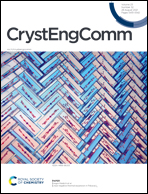Electrochemiluminescence properties and luminescence sensing of four novel polymers derived from 3-(pyrazin-2-yl)-1H-pyrazole-5-carboxylic acid†
Abstract
On the basis of the 3-(pyrazin-2-yl)-1H-pyrazole-5-carboxylic acid (H2L) ligand, four new polymers [Cu2(L2−)2] (1), [Zn3(L2−)2(H2O)4Cl2]n (2), [Pb(HL−)Cl]n (3), and {[Ni(L2−)(H2O)]·(H2O)}n (4) have been synthesized under solvothermal conditions. Polymer 1 possesses a discrete (0D) binuclear structure, which is further formed into a three-dimensional (3D) supramolecular structure by hydrogen bonding and π⋯π stacking interactions. Polymers 2 and 3 display one-dimensional (1D) infinite chain structures, which further extend into 3D supramolecular structures through hydrogen bonding interactions. Polymer 4 features two-dimensional (2D) layers which can form a 3D supramolecular architecture via interlayer hydrogen bonds. The ligand in the four polymers adopts different coordination modes for constructing versatile structures. Moreover, luminescence sensing study shows that polymer 2 is a promising luminescent sensor for the detection of Cu2+, Co2+ and Fe3+via drastic luminescence quenching in aqueous solution with high efficiency. The quenching constants KSV for Cu2+, Co2+ and Fe3+ are 6.35 × 103 M−1, 8.70 × 103 M−1 and 1.62 × 104 M−1, respectively. What's more, 1–4 with electrochemical luminescence (ECL) properties show high intensity in N,N-dimethylformamide (DMF) solution and high thermal stability.

- This article is part of the themed collection: Coordination Networks


 Please wait while we load your content...
Please wait while we load your content...